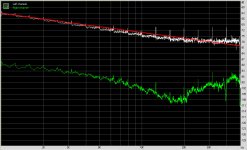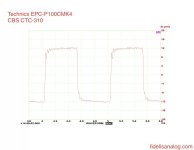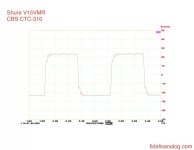The two FR curves with and without Riaa correction seem to prove that.Hi,
This was posted in a danish forum. Perhaps Google translate can help or otherwise let me know and I will try.
Maerkelig frekvensgang - HiFi2You
He says that Ortofon told him he should measure without RIAA correction.
Mogens
Hans
Wow, that’s a fantastic collection that you own.I'm happy to go through my test records to see if I've any that are exceptionally low noise. Scott it'd help to get your code so I can see what plays well with it. If I've one that works happy to send it on tour.
Last count I've around 50 test records - 3-4 copies of the Denon XG-7002 and 4-5 BK QR2010. QR2010 is CV above 1kHz but goes to 45kHz rather than the 50kHz the Denon does. These obviously won't go on tour but I've a lab setup that's super easy to do needle drops from comprised of an SP-10R or MK3, EPA-500, flat balanced instrumentation amp, RME ADI-2 PRO ADC, and Tascam DA-3000 for quick captures. Anything I have that's interesting I can record and post.
I also have a large collection of high-bandwidth carts with some examples that seem as healthy as one could hope for - P100CMK4 with ~5 good OEM styli, P205CMK4 with ~4 styli, P205CMK3 with one good styli, Sony XL-88D. The last still sealed so no idea on that one.
I also think I've a BK 8307 accelerometer on the way to use as a vibrator per their tech article. That one may be a bit above my brains and time capacity, so if someone like Scott is interested in trying that method I could loan it out. I'd like it back at some point with a repeatable method so I can use it on my above carts.
Very understandable that they are exclusively for own use.
Anxious to hear what your findings are for the Ortofon vs Denon record.
Hans
That’s way more accurate in getting results.
I'll leave you to your opinions and let's let it be, there is nothing wrong with anything I am doing. You will have to figure it out on your own. I would never use LTSpice for this rather Matlab, Octave, or Python it is not a full featured signal processing tool.
Last edited:
Good luck,there is nothing wrong with anything I am doing.
Hans
JP has all the best toys!
Looks like we can start to look at cantilever issues a little as well 🙂. My cantilever test platform is the AT22 and so far I have Be, Boron and cactus. I'm unconvinced about zirconia and sapphire other than the lovely B&O hollow sapphire cantilevers, but happy to be persuaded.
Back on test records and as I mentioned I think we have a number of different things going on with all the loose ends being tugged at. I really like the idea of spinning up a record and then recording as it runs down on fixed tones, but I assume this will have a practical higher frequency limit?
My interest at the moment is still trying to understand 5kHz to 35kHz JPs plots for the V15V show what I am expecting from the ortofons at higher frequency and I'm still of the feeling that the explanation is mainly electrical until I can prove otherwise. And for a practical consideration I need to understand how different cartridges react into a transamp at high frequencies.
So I think a multipronged approach is inevitable although looking forward to behaving like a small kid again spinning up records by hand 😀.
BTW Jico has officially re-launched SAS yesterday. Prices are more sensible than they were!
Looks like we can start to look at cantilever issues a little as well 🙂. My cantilever test platform is the AT22 and so far I have Be, Boron and cactus. I'm unconvinced about zirconia and sapphire other than the lovely B&O hollow sapphire cantilevers, but happy to be persuaded.
Back on test records and as I mentioned I think we have a number of different things going on with all the loose ends being tugged at. I really like the idea of spinning up a record and then recording as it runs down on fixed tones, but I assume this will have a practical higher frequency limit?
My interest at the moment is still trying to understand 5kHz to 35kHz JPs plots for the V15V show what I am expecting from the ortofons at higher frequency and I'm still of the feeling that the explanation is mainly electrical until I can prove otherwise. And for a practical consideration I need to understand how different cartridges react into a transamp at high frequencies.
So I think a multipronged approach is inevitable although looking forward to behaving like a small kid again spinning up records by hand 😀.
BTW Jico has officially re-launched SAS yesterday. Prices are more sensible than they were!
the 4th President of the US, James Madison, once spoke these wise words.
No man is allowed to be a judge in his own cause, because his interest would certainly bias his judgment, and, not improbably, corrupt his integrity.
I have ordered the Ortofon record at Amazon, anxiously awaiting the forthcoming results.
Hans
No man is allowed to be a judge in his own cause, because his interest would certainly bias his judgment, and, not improbably, corrupt his integrity.
I have ordered the Ortofon record at Amazon, anxiously awaiting the forthcoming results.
Hans
the 4th President of the US, James Madison, once spoke these wise words.
No man is allowed to be a judge in his own cause, because his interest would certainly bias his judgment, and, not improbably, corrupt his integrity.
I have ordered the Ortofon record at Amazon, anxiously awaiting the forthcoming results.
Hans
I’m sorry to say but think you will be a bit dissapointed with the quality of the Ortofon sweeps.
Unorthodox r us.Wow, just what I was thinking the other night. I'm glad you are willing to entertain such an unorthodox hack. 🙂
If we take relatively short timeslices of fixed duration each will have a smear across f domain buckets, but a detector can isolate mean f an an integral will reveal amplitude, over a very restricted bandwidth we're interested in. Having kicked this about in polar plot sw, I'm amazed at accuracy and noise rejection.
No need to be too accurate with f this time, in favour of amplitude. And can use multiple or overlapping results or runs to build a composite f response.
How to give it enough range from a single test tone is a challenge...…..
LD
Last edited:
If you check it out most of the exotics are available as industrial/commercial rods in diameters suitable for cantilevers. If one is into DIY! But also explains why such an odd collection of materials that don't really suit in theory............ Diamond rod is also avail........Looks like we can start to look at cantilever issues a little as well 🙂. My cantilever test platform is the AT22 and so far I have Be, Boron and cactus. I'm unconvinced about zirconia and sapphire other than the lovely B&O hollow sapphire cantilevers, but happy to be persuaded.
LD
This is JP's sweep presented as instantaneous frequency and amplitude (dB re: arbitrary level) vs time in seconds. This must be the Lenco since the frequency wiggle is very low.
@JP The problem I am have is converting this to amplitude vs. frequency automatically. It is the same code I used for the TT speed plots with filtering set at 10Hz to help remove the tick and pop noise. Another issue is the same one I had before the Hilbert transform (like all transforms) is circular so there is a big jump at the end points due to the sudden frequency change.
I tried binning in 1Hz bins and averaging the amplitude of each point that is within +-0.5Hz but the number of points in each bin varies a lot so I have to keep track of the number and divide at the end. This is a little clumsy so I don't have much to show yet because some sweeps still need hand removal of major glitches.
@Hans I hope you will stay with us, I don't understand you can take any tool like Cooledit or Audition and sample a small slice of a sweep and get the average frequency and rms amplitude to test the results. I just did they are exactly the same.
@JP The problem I am have is converting this to amplitude vs. frequency automatically. It is the same code I used for the TT speed plots with filtering set at 10Hz to help remove the tick and pop noise. Another issue is the same one I had before the Hilbert transform (like all transforms) is circular so there is a big jump at the end points due to the sudden frequency change.
I tried binning in 1Hz bins and averaging the amplitude of each point that is within +-0.5Hz but the number of points in each bin varies a lot so I have to keep track of the number and divide at the end. This is a little clumsy so I don't have much to show yet because some sweeps still need hand removal of major glitches.
@Hans I hope you will stay with us, I don't understand you can take any tool like Cooledit or Audition and sample a small slice of a sweep and get the average frequency and rms amplitude to test the results. I just did they are exactly the same.
Attachments
Last edited:
If you don’t shoot, you will never hit a target. I’ll give it try and when I don’t like it, there’s always an Ebay to sell it. 😀I’m sorry to say but think you will be a bit dissapointed with the quality of the Ortofon sweeps.
Thanks for the warning anyhow, I’ll be extra critical in my evaluation.
Hans
Yes, gone are the days of Shure patenting cantilever manufacturing processes. I suspect Namiki make 80% of worlds cantilevers now. The 205CII I have is thinwall Ti to see if I can find out anything about that cw other materials.If you check it out most of the exotics are available as industrial/commercial rods in diameters suitable for cantilevers. If one is into DIY! But also explains why such an odd collection of materials that don't really suit in theory............ Diamond rod is also avail........
LD
Dr Weinz was definitely a Boron lover. If only there was an industrial need for boron tube.
But we live in a world where a boron rod cantilever replacement with exotic diamond can be cheaper than OEM new. In this scenario due diligence should be done on if there is anything there.
A few suggestions/comments on these very nice images:This is JP's sweep presented as instantaneous frequency and amplitude (dB re: arbitrary level) vs time in seconds. This must be the Lenco since the frequency wiggle is very low.
@JP The problem I am have is converting this to amplitude vs. frequency automatically. It is the same code I used for the TT speed plots with filtering set at 10Hz to help remove the tick and pop noise. Another issue is the same one I had before the Hilbert transform (like all transforms) is circular so there is a big jump at the end points due to the sudden frequency change.
I tried binning in 1Hz bins and averaging the amplitude of each point that is within +-0.5Hz but the number of points in each bin varies a lot so I have to keep track of the number and divide at the end. This is a little clumsy so I don't have much to show yet because some sweeps still need hand removal of major glitches.
@Hans I hope you will stay with us, I don't understand you can take any tool like Cooledit or Audition and sample a small slice of a sweep and get the average frequency and rms amplitude to test the results. I just did they are exactly the same.
1) it might give some extra info when the Y axis for the frequency is logarithmic, this should then result in a straight line
2) it would also be nice to have both curves in one image with two left/right Y axes for level and frequency
3) I have little doubt in JP's super performing cartridge, but the shown level line is what his Cart has produced and not necessarily what's on the record.
A record that is analysed this way should be level validated in some way, preferably by comparing several Carts in the same high bandwidth category.
If not, someone might think with this image that his cart has a dip at ca. 12kHz and a peak at 50khz, which might either be true or not at all.
Hans
As a matter of fact, level and frequency vs time in Scott's image, taken from JP's Denon sweep, do correspond impressively well with the deviation from the red line in the FFT spectrum.
So before jumping to conclusions about FR you have to know the whole story.
This Cart seems to be real gem.
Hans
So before jumping to conclusions about FR you have to know the whole story.
This Cart seems to be real gem.
Hans
Attachments
The EPC-P100CMK4 (hope I have that right) is the absolute zenith of the low mass era of MM just before CD came out. 0.055mg effective tip mass with a boron tube cantilever. It also had a trick suspension that was less affected by temperature than Butyl rubber, which became its weak point. A lot of them suffered rubber rot apparently. Truly SOTA when they came out and arguably have not been bettered since.
Yep. P100CMK4 T4P version or 100CMK4 SME.
Looks good, IIRC the mid-range droop causes a tilt of the top of the square wave response which shows up for my cart. It should be possible to reconstruct a minimum phase square wave response from the data and compare it to the actual square wave response.
Is that square wave also no RIAA?
Correct no RIAA. This is a Shure V15V/VN5MR.
Attachments
Last edited:
So long as f doesn't change too much in each timeslice, FFT of each timeslice will report amplitude for integration by summing over a certain bandwidth, and either FFT or HT can deliver the mean f. The bandwidth might need to be carefully chosen or adaptive, but I think each timeslice contains equal energy modified only by rpm which is a restatement of mean f. So I really think all the elements are there...………………The problem I am have is converting this to amplitude vs. frequency automatically.
LD
- Status
- Not open for further replies.
- Home
- Source & Line
- Analogue Source
- Cartridge dynamic behaviour



